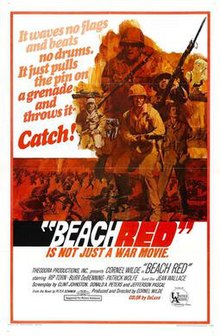Beach Red
| Beach Red | |
|---|---|
 Theatrical release poster | |
| Directed by | Cornel Wilde |
| Written by | Story: Peter Bowman Screenplay: Clint Johnston, Don Peters, Cornel Wilde |
| Starring | Cornel Wilde Rip Torn Burr DeBenning Jaime Sánchez |
| Cinematography | Cecil R. Cooney |
| Edited by | Frank P. Keller |
| Distributed by | United Artists |
Release date | 1967 |
Running time | 105 minutes |
| Country | United States |
| Language | English |
Beach Red is a 1967 World War II film starring Cornel Wilde (who also directed) and Rip Torn. The film depicts a landing by the U.S. Marine Corps on an unnamed Japanese held Pacific island, however is thought to be Red Beach, Palo, Leyte in the Philippines. A reference to the recent Bougainville Campaign early in the film presumably dates the action to November 1943 or later. During World War II Allied amphibious operations, designated invasion beaches were code named by colour; such as Beach Red, Beach White, Beach Blue etc.
The film is based on a lengthy piece of prose, not quite a novel written by Peter Bowman based on his experiences with the US Army Corps of Engineers in the Pacific Islands campaigns.
Plot
The opening sequence of an opposed beach landing bears a stylistic resemblance to Saving Private Ryan, even though there is more than thirty years between the productions. In one scene during the landing a Marine is shown with his arm blown off similar to Tom Lea's painting The Price.
As Americans are shown consolidating their gains, flashbacks illustrate the lives of American and Japanese combatants. Shifting first person voice over in a stream of consciousness style is also used to portray thoughts of numerous characters. Like Wilde's previous production of The Naked Prey the film does not use subtitles for characters speaking Japanese.
The film contains large sections of voice over sections, often juxtaposed with still photographs of wives etc. (who inexplicably are dressed in 1967 attire rather than WW2). It contains a huge amount of crying by the troops, and an abnormal sympathy for the enemy. In one scene an injured marine is lying close to an injured Japanese soldier in a scene paralleling the famous scene in All Quiet On The Western Front just after they bond, other marines appear and kill the Japanese soldier causing distress to the first marine.
Director, producer, and co-writer Wilde plays a Marine Captain the company commander, Rip Torn plays his believable company gunnery sergeant who says the film's tagline "That's what we're here for. To kill. The rest is all crap!" .
Production
- Filmed on location in the Philippines using troops of the Philippine Armed Forces. The sequence of the Japanese dressed in Marine uniforms was inspired by the original book mentioning Japanese wearing American helmets to infiltrate American lines.[1]
- When seeking assistance from the U.S. Marine Corps, Cornel Wilde was told that due to the commitments of the Vietnam War all the Corps could provide the film was color stock footage taken during the Pacific Island campaigns. The film provided had deteriorated so Wilde had to spend a considerable part of the film's budget to restore the film to an acceptable quality in order to blend into the film. The Marine Corps was grateful that their historical film had been restored at no cost to them.[2]
Added Production note; Even though a lot of the amphibious land scenes was stock footage Mr. Wilde did include actual landing barge footage with actual pyrotechnics' going all around us, as we hit the water. We did go down the nets into the boats. I say we, as I was one of them, along with several American military on leave from Base's around the Philippine's. Air Force, Navy, Army and Marines, who where serving over there during Viet Nam getting some R&R. Some of us who also had been in Country at one point in time supporting the troops in country. I was part of the casting crew and if you see the film some of us listed in the credits as they roll at the end. See me as Private Bill, that was me that you read about in the plot who gets killed. #BillyDunbar
Soundtrack
The film only has one musical theme, a song by written Antonino Buenaventura that appears in the titles sung in a folk song manner by Jean Wallace and appears in various orchestrations throughout the film. The titles of the film are various paintings that suddenly segues into the preparations for the landing.
Quotes
Nobody's talking themselves red, white and blue in the face and only the sea is behind you if you turn.
It's just you and your firearm, the enemy and his, and a perfectly democratic opportunity to use your own judgement.- Bowman, Peter Beach Red: A Novel Random House, 1945
